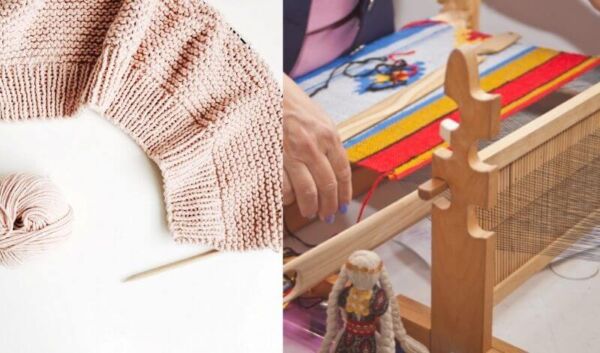Knitting is a form of hand-based textile production that involves interlocking loops of yarn or thread on needles to create a fabric.
On the other hand, weaving is an ancient technique in which threads are passed over and under one another within two sets of parallel threads called the warp and weft.
Knitting is sometimes considered a faster, more efficient version of weaving because it produces a fabric in one piece without the hassle of fixing mistakes. Is this true? Is

What is the difference between knitting and weaving?
The main difference between weaving and
In fact, if you have ever made a friendship bracelet, that is an example of weaving. You get the two sets of strings and make them pass through each other at regular intervals to form the bracelet.
Another difference between
There are two reasons for this. First, when you knit a piece of fabric, the loops that form all lie on the same side, making it easier to handle and carry – no need to flip over like in weaving. Second, knitting uses smaller diameter yarn than weaves do.
Both techniques do have their advantages and disadvantages but, in this article, we will focus on which is faster: weaving or
Knitting vs. Weaving: How Is It Done?
The process of
- Preparing the yarn for knitting.
- Making the knit stitches.
- Putting these stitches together to form fabric.
The first part involves re-orienting the yarn from a skein of loosely wound strands to one long strand that can be looped through needles. This is accomplished using tools like the ball winder.
Once you have this,

The entire process is kept in rhythm by a method called
On the other hand, weaving is a technique where weft threads go over and under fixed warp threads to create fabrics. You may recognize this form of weaving from the fabric that forms handbags or backpacks.

It is called plain weave because all threads are interlaced through one another, giving it a flat appearance.
The structure of this fabric makes it easier to track the warp and weft threads: they are all either over or under each other. We can also see that woven fabrics use a lot more material than knitted ones – even though handwoven garments require less yarn than machine-made clothes, they still need more time to be made compared to knitted ones.
Who should knit, who should weave, and why?
It is time to go over the two techniques and determine which one can be more efficient based on who they are intended for. Is it better to weave or knit?
Firstly,
Things to consider when choosing knitting over weaving:
– Is your project going to be very big? Is it something that you want to keep for a long time or give as a gift to the people close to you? If so, then
– Is it a gift for someone who is going to wash this piece? If you want the final product to look as new as possible, then knitting may be an option since it uses smaller yarn and tighter stitches – they both make the fabric sturdier.
– Is there any chance that your item will get too hot or too humid?
– Is your project going to require a lot of washings? It is important to remember that
– Is your project going to be very delicate? Is it something that needs to look flawless and feel soft? If so, then weaving is a better choice. It allows the creation of thicker fabrics with better drapes, which makes for a more luxurious item of clothing.
In conclusion…
knitting is a great option and faster handcrafting for creating clothes, accessories, or other pieces of fabric, and it is very versatile.
It is obviously more time-consuming to make a woven piece of clothing – but that does not mean that you should always go with
Hope you have learned something new today, and let me know if you have any questions!

